Hishi Mochi and Hina Matsuri
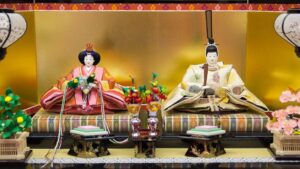
O-dai-ri-sama, お内裏様, Hon.-inner-back-forms, the principle figures of the dolls of Hina Matsuri, 雛祭り, Chick Festival, representing the emperor on the right and the empress on the left. Hina Matsuri is part of the time of the year named Momo no se-kku, 桃の節句, Peach’s divide-season, observed on the 3rdday of the 3rd month according to the lunar calendar, however in modern times it is most often celebrated on March 3.
Placed before the figures pictured above are rhombus-form sweets called hishi mochi, 菱餅, diamond mochi, that are presented on hishi dai, 菱台, diamond supports. Part of the display are a sa-kon no sakura, 左近桜, left-near ’s cherry, a cherry tree placed to the emperor’s left side, and an u-kon no tachibana, 右近橘, right-near ‘s mandarin orange, an orange tree placed to the empresses’ right side. ‘Left’ and ‘right’ are relative to the orientation of the imperial couple who are ideologically facing south.
The multi-colored fabric tatami heri, 縁, edge, includes a similar hishi pattern.
Hina Matsuri is part of the Momo no Sekku, which, according to the lunar calendar, occurs in April at a time when the peach tree blooms. In China, the New Year is celebrated with gifts of peach blossoms and trees, which are symbolic of longevity.
The dolls are collectively called o-hina-sama, お雛様, hon.-chick-form, are identified as ‘chicks’, hina, 雛, diminutive prefix, and carry favorable connotations such as a sense of ‘cuteness’. The word sama, 様, following a name or title, may be likened to the suffix -ship, as in the phrase, ‘your lord-ship’.
This placement of the imperial couple is displayed with their backs to the north, and locating the emperor on the right places him toward the east and the rising sun, his heavenly ancestor. Their juxtaposition is the typical arrangement in Kyōto and western Japan, whereas placing the emperor on the left is typical of Tōkyō, and eastern Japan.
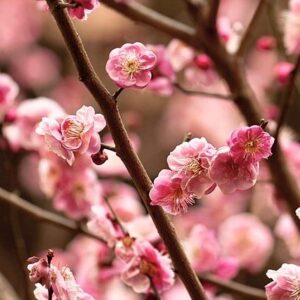
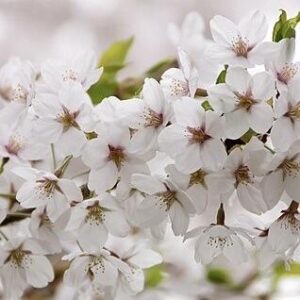
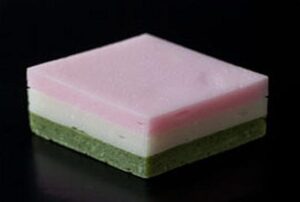
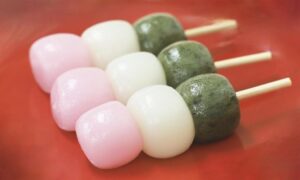
Hishi-mochi, 菱餅, rhombus-mochi, is made of mochi-gome, 餅米, mochi-(glutinous)rice, that is sweetened and colored: pink is flavored with gardenia seeds, white is flavored with water chestnut, and green is flavored with mugwort. They are offered and served on Hina-matsuri, 雛まつり, Chick-festival. The diamond-shape appears in the Asuka period, exclusively for the imperial court, and its four corners are symbolic of Yō, 陽, Yang, positive, radiating out in all directions.
There is a traditional manner in which one should eat the hishi-mochi. First, the four corners are eaten to create a circle, which symbolizes eternity, and then the circle is the eaten.
There is another traditional sweet eaten specifically when viewing cherry blossoms, called hana-mi dan-go, 花見団子, flower-see ball-of. The sweet is made of three balls of mochi on a bamboo kushi, 串, skewer, of three different colors, san-shoku, 三色,three-colors: pink, white, and green. Pink represents the young buds that emerge on bare branches in early spring. White represents the five-petaled blossoms at their peak. And finally, green symbolizes the leaves that grow out of the branches once the last petals have fallen off the tree. Although the sweet can be eaten at any time of the year, they were made for viewing cherry flowers, sakura, 櫻. The same three colors are present in the hishi-mochi, 菱餅, diamond mochi. As such, the colors may not refer specifically to cherry, although peach blossoms pink and green, white is so evident.
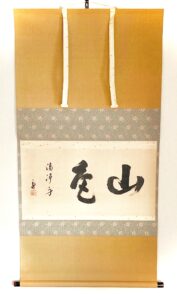
The three colors of pink, white, and green, san-shoku, 三色, three colors, are present in many aspects of Japanese culture. Hence the three-colored sweets, such as hana-mi dango, are also called san-shoku dan-go, 三色団子, three-color ball-of. San-shoku is wordplay on san-shoku, 山色, mountain color/form. There is a familiar Buddhist expression, ‘San-shoku Shō-jō–shin’, 山色清浄心身, Mountain-form/color Pure-pure-body, which likens the land to the pure body of the Buddha.
Cherry blossom viewing began as a Shintō ritual for purification. The origin of ‘sakura’ is found in the name of the god of rice, Sa, and kura means the seat where the god rests. During flower viewing, people would make offerings to this tree, pray for a good harvest, and hold parties. Special hana-mi dango were made to enjoy during the festivities, and in Shintō, the colors of pink, white and green have meaning. The theory is that the color pink is for the cherry and white kō-haku, 紅白, red-white, which are manifestations of In and Yō, are regarded as auspicious, and green is to ward off evil spirits. Pink and white represent female and male, and green represents life.
Another theory is that the cherry blossom pink represents spring, white is for winter snow, and green is for summer. Autumn appears to be left out; however, one should not forget the bamboo kushi, 串, skewer, with is golden yellow perhaps for autumn.
In the spring bamboo leaves turn rather yellow. This is because they provide their nutrients to their bamboo shoots growing fast and straight. Because of the natural life cycle of bamboo, there is an expression, haru wa take no aki, 春は竹の秋, spring is bamboo’s autumn, and conversely, aki wa take no haru, 秋は竹の春, autumn is bamboo’s spring. Therefore, the green bamboo skewer of the hanami dango may represent autumn.
Sen To-mi-ko, 千登三子, Thousand Ascend-three-child, wife of Hō-un-sai, ‘Phoenix’-cloud-abstain, XV, in her book on the simple and sumptuous Wa-ga-shi, 和菓子, Harmony (Japan) -sweet-of, “An Almanac of Urasenke Seasonal Tea Sweets”, Tankōsha, Kyōto. She wrote that the kushi, 串, skewers for the hanami dan-go are made of square-section ao–dake, 青竹, green-bamboo, which gives a fresh spring feeling.

Painting of Ari-wara Nari-hira, 在原業平, Outskirts-field Vocation-peace (825-880), aristocrat and poet. The diamond pattern of his apparel was a familiar design among the aristocracy. Note the intensity of the green color which is to emphasize the newness of the mat, ao tatami, 青畳, green-mat, on which he sits. The tatami black and white fabric heri, 縁, edge, frequently has a hishi-gata, 菱形, diamond-shape, pattern, which is typical of tatami for the aristocracy.
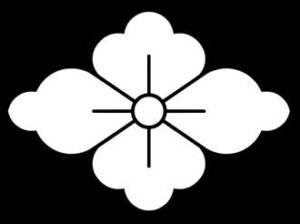
Crest design of hishi no hana, 菱の花, rhombus of flower, water chestnut flower, is a familiar Japanese family crest in a multitude of variations. This floral design is also called hosoge, ほそげ.
The word hishi written with the Kanji, 菱, means water caltrop (esp. Trapa japonica); water chestnut.
Caltrop is also a pointed throwing weapon, diamond shape, rhombus. It is thought that it is derived from the seed pod of the caltrop.
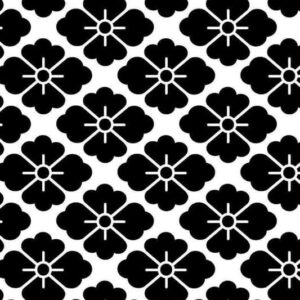
Hishi-gata, 菱形, rhombus-shape this hishi, 菱, rhombus, is the same Kanji used in hishi-mochi, 菱餅, rhombus-mochi, which is a sweet traditionally served at the imperial court.

Another familiar example of a stylized rhombus shape is the design named matsu-kawa bishi, 松皮菱, pine-skin rhombus, which is a highly stylized motif of the fissures of pine bark.
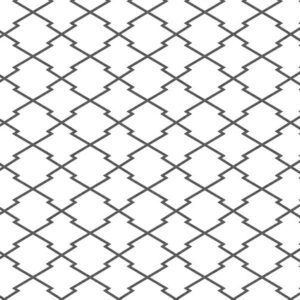
The hishi, 菱, water caltrop, called a water chestnut, is unlike its namesake, water chestnut or Chinese water chestnut, is the kuro gu-wai, 黒慈姑, black mercy-mother-in-law, Eleocharis dulcis var. tuberosa. Other Kanji for the hishi plant includes 蔆 , 芰 , etc.
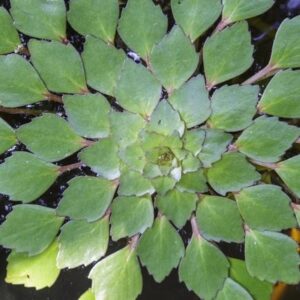
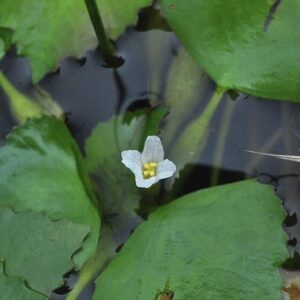
The hishi, 葉, plant, genus Trapa, grows in fresh flowing waters, with its roots in the mud and stems that measure twelve to fifteen feet, and its leaves float of the surface of the water. In the photograph with the flower, the air-filled fukuro, 袋, sacs, bladders cause the stems and leaves to float. The remarkable looking fruits are woody burrs that are variously called buffalo nut, bat nut, devil pod, ling nut, mustache nut, singhara nut or water chestnut. Identified as a water chestnut has caused some confusion as to the identity of the water chestnut.
Trapa comes from the Latin for thistle, after the fruits four sharp points. The inner white seed is edible and can be eaten raw and cooked. The seeds are made into a starch. The seed can be viable for around twelve years. Each plant can produce about one thousand fruits. The seeds have been worshipped in China since the 2nd century BC.
They bear ornately shaped fruits, which in the case of Trapa bicornis resemble the head of a bull or the silhouette of a flying bat. Each fruit contains a single very large, starchy seed. Trapa natans and Trapa bicornis have been cultivated in China and the Indian subcontinent for the edible seeds for at least 3,000 years. Depending on its locale, the plant is a noxious pest and an invasive species in the US from Vermont to Virgina, while elsewhere it is cultivated for profit.
The fruit develops from the fertilized flower and matures under water. It is remarkable that from a tiny, fragile looking simple four petal flower produces a large, thorny burr, that seems threatening. The seed develops a very hard pericarp, which resembled the ancient metal weapon caltrop with four points that were often barbed. The caltrop that was known in the second century BC in Persia. The Greeks used it widely. The weapon was thrown or many strewn on the ground to incapacitate humans, horses, elephants, camels, etc. The caltrop is so made that one of the four spikes always points upwards. The etymology of the caltrop has its origins in Old English calcatrippe, heel-trap. The word ‘caltrop’ is related to the hishi plant genus Trapa, after its resemblance to the metal spiked weapon.


The caltrop weapon familiar in Japan is called a maki-bishi, 撒き菱, scatter-rhombus. There are two different plants that are identified as water chestnuts. In Japan, the water chestnut is called a hishi, 菱, water caltrop (esp. Trapa japonica); water chestnut. The Kanji, 菱 , also has the meaning of diamond shape, a rhombus. The other plant called ‘water chestnut’ is actually known in Japanese as kuwai, with the Latin name of Eleocharis dulcis. Both plants grown in swampy conditions, and bear an edible tuber and is not to be confused with Chinese water chestnut.
The water caltrop is any of three extant species of the genus Trapa: Trapa natans, Trapa bicornis and the endangered Trapa rossica. It is also known as buffalo nut, bat nut, devil pod, ling nut, mustache nut, singhara nut or water chestnut, hence, some confusion may occur.
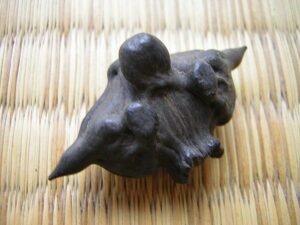
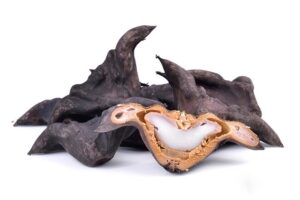
The hishi, called a water chestnut, is unlike its namesake, water chestnut or Chinese water chestnut, that is the kuro gu-wai, 黒慈姑, black mercy-mother-in-law, Eleocharis dulcis var. tuberosa.
The caltrop in Chinese, is 白蒺藜, Bai Ji Li (Caltrop Fruit, Fructus Tribuli, 白蒺藜). Bai Li Ji is a traditional Chinese herb that is also known as Caltrop Fruit. It soothes the liver Yang and liver Fire. It also treats head disorders caused by liver Yang rising with symptoms such as dizziness, headache, vertigo, blurred vision, bitter taste in the mouth and hypertension. It helps to dispel wind-heat, clear the eyes, and stop itching. It promotes the smooth flow of qi [chi] Japanese ki, 氣, life energy, in the chest, flank pain, distention, and insufficient lactation. Bai li ji is a bitter, pungent, slightly salty and enters through the liver meridians.
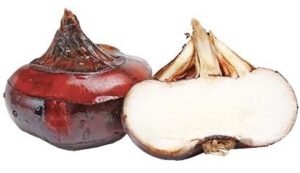
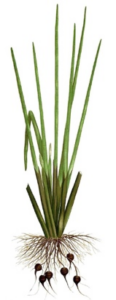
Eleocharis dulcis, the Chinese water chestnut or water chestnut, is a grass-like sedge native to Asia, tropical Africa, and Oceania. It is grown in many countries for its edible corms. The water chestnut is not a nut but rather an aquatic vegetable that grows in marshes, under water, or in mud. It has stem-like, tubular green leaves that grow to about 1.5 m, or 5 ft. The water caltrop, which also is referred to by the same name, is unrelated and often confused with the water chestnut. The small, rounded corms have a crisp, white flesh and may be eaten raw, slightly boiled, or grilled, and often are pickled or tinned. They are a popular ingredient in Chinese dishes. In China, they are most often eaten raw, sometimes sweetened.
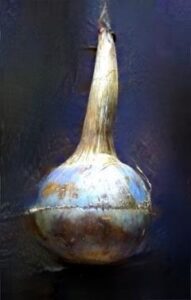
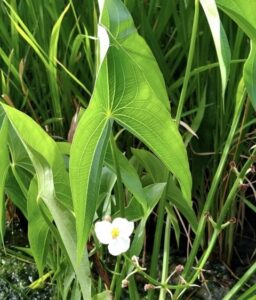
Kuwai, 慈姑, mercy-mother in law, Sagittaria trifolia var. edulis, water chestnut: usually written in Katakana,クワイ.
The kuwai has become identified with the word hishi, because of the translation to ‘water chestnut’. The familiar water chestnut found often in Chinese dishes is the kuwai. It is a variant of the three-leaf arrowhead plant, and is grown for its edible corms. The name kuwai comes from the resemblance of the shape of the leaf to a kuwa, 鍬, hoe, which was used to dig up potatoes, imo, 芋, to form kuwa-imo, that was contracted to kuwa-i.
Kuwai, 慈姑, is gathered between November and December. The arrowhead tubers (kuwai) are aquatic perennial plants. In Japan, these are one of many celebratory and good-fortune bringing ingredients in traditional Japanese New Year’s cuisine, O-se-cchi ryō-ri, 御節料理, Hon.-season materials-arrangement, an elaborate array of preserved foods presented in gorgeous, multilayered lacquered boxes. Kuwai tubers sprout easily and vigorously, and are regarded as a symbol of successful life and good luck in the future. There are 3 types of arrowhead tubers, blue, white and the Suita variety (produced in Suita City, Western Japan). However, the blue arrowhead tuber (shown here) is the most commonly available. These vegetables have a distinct mild bitterness.
Swamp waters have various types of plants, including Chinese water chestnut (Eleocharis dulcis). Chinese water chestnut is wild plants that can live in swamp waters. Chinese water chestnut has been used as a traditional medicine to treat hypertension, constipation, and chronic nephritis.
![]()
Imperial Kinin service in Tea
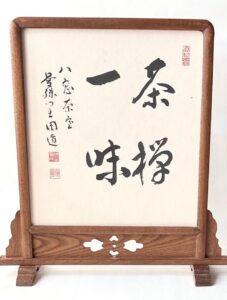
Shiki-shi, 色紙, color-paper, with calligraphy, Cha Zen ichi mi, 茶禅一味, Tea Zen one taste, written by Yama–guchi En-dō, 山口圓道, Mountain-opening Circle-way, abbot of Man-shu-in, 曼殊院, Wide-especially-temple, Kyōto; 9 x 8 sun kane-jaku. Tea hut named Ha-ssō-ken, 八窓軒, Eight-window-eave. Shiki-shi tate, 色紙立, color-paper stand made of kuwa, 桑, mulberry, with sukashi, 透かし, open-work, in the shape of hishi-bana, 菱花, diamond-flower.
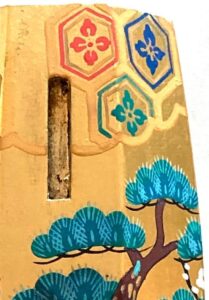
Detail – octagonal buri-buri kō-gō, ぶりぶり香合, swell-swell incense-gather, L. 5.5 sun kane-jaku. Note hishi bana, 菱花, rhombus flower, set inside ro-kkaku, 六角, six-corners. The rhombus suggests the number 8, symbolic of Infinity in Space. The hexagon suggests the six-sided scales of the tortoise shell that is thought to live ten thousand years, and is symbolic of Infinity in Time. The evergreen pine tree is an emblem of longevity. Pine needles are other examples of sue-hiro, 末広, ends-wide, a concept closely associated with Infinity in Space. The needle clusters begin at one point and radiate outward in various directions, and as they are a part of the pine tree, they are symbolic of being ever-green, Infinity in Time.
In geometric symbolism, almost any angle is a manifestation of suehiro, which is emblematic of Infinity in Space. A folding fan, sen-su, 扇子, fan-of, is a good example of suehiro, beginning at a point and radiating outward to ‘infinity’. A rhombus has four corners, the ends of which are stopped by the opposing corner, therefore, impeding ‘infinity’. Eating the corners of the hishi mochi to form a circle, is symbolically creating infinity, the circle, by removing the angled corner barriers.
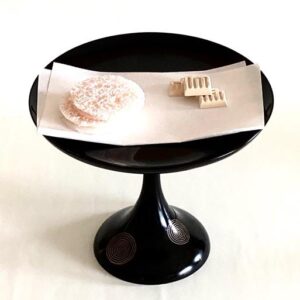
Hi-ga-shi, 干菓子, dry-sweets-of, presented on a sheet of kai-shi, 懐紙, heart-paper, placed on a taka-tsuki, 高杯, high-cup, used when serving ki-nin, 貴人, noble-person. The sheet of paper is folded somewhat at an angle with the top layer to the right of the bottom layer. This manner of folding the paper, which is auspicious, differs from paper folded with the top layer to the left of the bottom layer, which is reserved for offerings to spirit. The folded paper creates a kind of hishi, though it has six corners.
The higashi pictured are raku-gan, 落雁, alight-geese, at the right, and sen-bei, 煎餅, toasted-mochi, sandwiched with sweetened ume-boshi, 梅干し, Japanese apricot-dry.
Correctly, two kinds of hi-ga-shi, 干菓子, dry-sweet-of, are offered to the guests at a Tea gathering. Two sweets are offered to encourage the guest to have more than one bowl of tea. One of the sweets should be raku-gan, 落雁, alight-geese, which is made of molded or pressed fine sugar and a kind of glutinous rice flour. It is regarded as shin, 真, true, as this type of sweet was and is given at shrines and temples. Its proper place on the hi-ga-shi bon, 干菓子盆, dry-sweet-of tray, is on the far right quadrant. The second sweet may be anything provided it is dry to the touch and can be eaten with the fingers. Its proper location is one the near left quadrant of the tray. When using the takatsuki, adjustments are made when placing the sweets.
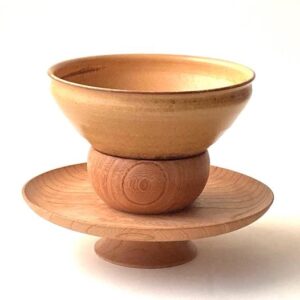
Cha-wan; ceramic Ten-moku-gata, 天目型, Heaven-eye-shape, with wheat color glaze, Ki-kkō yaki, 吉向焼, Good luck-beyond-fired; diam. 4.4 x 2.3 sun kane-jaku. Made in 1963 for the 700th anniversary of the Shin-ran, 親鸞, Parent-mythic bird, [1173-1263] founder of the Jō-do Shin-shū, 浄土真宗, Pure-land New-sect, given at Higashi-Hon-gan-ji, 東本願寺, East-True-vow-temple, Kyōto. The three-part ki-nin dai is made of keyaki, 欅, zelkova – which is composed of ki, 木, tree, wood, and ageru, 擧, raise up. The shape of the Tenmoku chawan may be identified with the lotus seed pod, which is a water plant similar to the hishi, caltrop.
For further study, see also: Hina Matsuri, Tea in March Part 2, and Tea Sweets and Offerings

